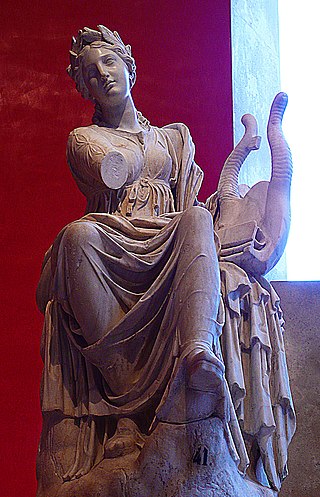Top Qs
Timeline
Chat
Perspective
Terpsichore
Muse of dancing and chorus in Greek mythology From Wikipedia, the free encyclopedia
Remove ads
In Greek mythology, Terpsichore (/tərpˈsɪkəriː/; Ancient Greek: Τερψιχόρη, "delight in dancing") is one of the nine Muses and goddess of dance and chorus. She lends her name to the word "terpsichorean", which means "of or relating to dance".

Remove ads
Appearance
Terpsichore is usually depicted sitting down, holding a lyre, accompanying the dancers' choirs with her music. Her name comes from the Greek words τέρπω ("delight") and χoρός ("dance").
Family
According to Hesiod's Theogony, Zeus lay with the Titan Mnemosyne each night for nine nights in Piera, producing the nine Muses.[1]
According to Apollonius of Rhodes, Terpsichore was the mother of the Sirens by the river god Achelous.[2] The Etymologicum Magnum mentions her as the mother of the Thracian king Biston by Ares.[3] According to the Byzantine scholar Eustathius, Terpsichore was the mother of the Thracian king Rhesus by the river god Strymon.[4]
Remove ads
In culture

Historical
- The British 32-gun frigate HMS Terpsichore (1785) commanded by Captain Bowen participated in the Battle of Santa Cruz de Tenerife (1797).
Literature
- When The Histories of Herodotus were divided by later editors into nine books, each book was named after a Muse. Terpsichore was the name of the fifth book.
Music and dance
- Terpsichore (1612) is the title of a large collection of dance tunes collected by Michael Praetorius, some originating with Pierre-Francisque Caroubel and some later adapted for wind ensemble by Bob Margolis.
- Terpsichore is also found in François Couperin's "Second Ordre" from the Pièces de clavecin.
- The third version (HWV 8c) of Handel's opera Il pastor fido (1712) includes a new prologue written in 1734 titled Terpsicore.
- The eighteenth century French dancer and courtesan Marie-Madeleine Guimard named the private theater in her private palace (1766) the Temple of Terpsichore.
See also
Notes
References
External links
Wikiwand - on
Seamless Wikipedia browsing. On steroids.
Remove ads

